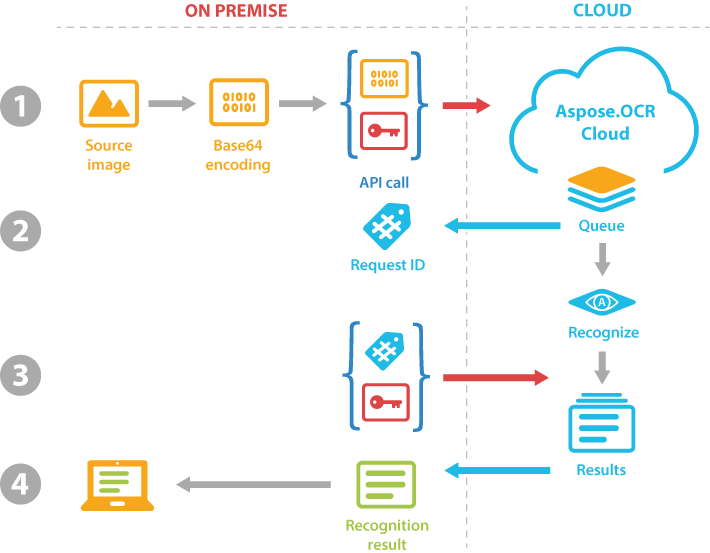Recognition workflow
Aspose.OCR Cloud can read even the most complex images or PDF documents with just 2 REST API calls or a few lines of code in any programming language supported by SDK. Read Hello, world! article for a hands-on example.

1. Submit image for OCR
Aspose.OCR Cloud can read all popular image formats as well as scanned PDF documents. The image is provided as a Base64 encoded string. You can also specify advanced recognition parameters in the request.
To authorize your requests to Aspose.OCR Cloud API, pass the access token in Authorization header of the request along with the image / PDF.
2. Get the request ID
Your recognition request is queued and you will receive a unique identifier that can be used to retrieve results or cancel the request.
For more information on what happens in the cloud, read Behind the scenes section.
3. Fetch the recognition result
Just call the Aspose.OCR Cloud API with the request ID to retrieve the recognized content and processing status. The recognition may take a second or two, depending on the size of the image and the current Aspose.Cloud load. For more information on what happens in the cloud, read Behind the scenes section.
To authorize your request, pass the access token in Authorization header.
It is also possible to get the request status by sending the GET request to https://api.aspose.cloud/v5.0/ocr/Utilities/GetTaskStatus endpoint with the unique identifier of the task in id query string parameter. This method does not return the results, allowing you to save the resources and traffic.
4. Process the recognition result
If the OCR process completes successfully, you will get back the recognition results in JSON format along with technical details. Recognized text, audio or file content will be encoded in Base64. After decoding, you can save it to disk, display on the screen, analyze, or write to a database.
Behind the scenes
OCR is a resource-intensive process that involves sophisticated neural networks and complex calculations. Even with high-performance GPU-based servers, this can take some time, especially when reading large images and long PDF documents.
To balance resources under high load and ensure reliable and secure operation, we have introduced queued processing. Instead of being immediately sent for recognition, the source image / PDF is placed in a queue under a unique identifier. The queue is constantly monitored and processed in the background using advanced load balancing techniques.
Once the image is recognized, the result is saved to internal storage, from where it can be retrieved using the unique ID within 24 hours after an OCR request has been made.